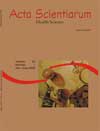<b>Avaliação do estado nutricional de pacientes em diálise peritoneal ambulatorial contínua (DPAC)</b> - DOI: 10.4025/actascihealthsci.v31i1.545
Résumé
Este estudo teve como objetivo avaliar o estado nutricional dos pacientes em DPAC. Foram selecionados 16 pacientes com idade entre 20 e 75 anos, nos quais foram realizadas Avaliação Nutricional Subjetiva Global modificada, avaliação antropométrica, bioquímica e da ingestão alimentar. O excesso de peso prevaleceu na população estudada, atingindo 68,75%, de acordo com o Índice de massa corporal. No entanto, a avaliação da área muscular do braço corrigida demonstrou que 62,5% dos homens apresentavam algum grau de desnutrição, o que não foi observado na população feminina. Os níveis médios de uréia, hemoglobina, hematócrito, potássio, fósforo, cálcio e produto cálcio/fósforo estavam dentro da normalidade para esses pacientes. A ingestão média de nutrientes estava adequada em energia, lipídeos, fósforo, ferro, potássio e ácido fólico; insuficiente em proteínas, fibras, cálcio e vitamina B6; e excessiva em carboidratos, sódio e vitaminas C e B12. Dessa forma, destaca-se que o acompanhamento nutricional é uma conduta de destaque nessa população, em virtude da elevada prevalência de distúrbios nutricionais e dietéticos.Téléchargements
DECLARAÇÃO DE ORIGINALIDADE E DIREITOS AUTORAIS
Declaro que o presente artigo é original, não tendo sido submetido à publicação em qualquer outro periódico nacional ou internacional, quer seja em parte ou em sua totalidade.
Os direitos autorais pertencem exclusivamente aos autores. Os direitos de licenciamento utilizados pelo periódico é a licença Creative Commons Attribution 4.0 (CC BY 4.0): são permitidos o acompartilhamento (cópia e distribuição do material em qualqer meio ou formato) e adaptação (remix, transformação e criação de material a partir do conteúdo assim licenciado para quaisquer fins, inclusive comerciais.
Recomenda-se a leitura desse link para maiores informações sobre o tema: fornecimento de créditos e referências de forma correta, entre outros detalhes cruciais para uso adequado do material licenciado.























5.png)







